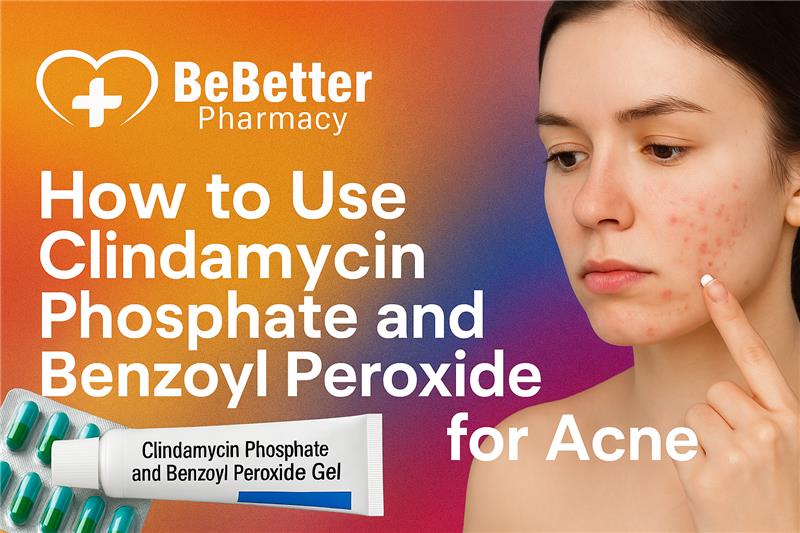Affecting people of all ages, acne is among the most often occurring skin disorders. Finding the correct treatment can improve your life whether you’re an adult breaking out or a teen adjusting to hormonal changes. Combining benzoyl Peroxide and Clindamycin Phosphate in a gel is one of the most successful prescription treatments on offer. Together, these two components combat acne-causing germs and lower inflammation. Like other drugs, though, safety and effectiveness depend on appropriate use.
This article will walk you through all you need to know about using Clindamycin Phosphate and Benzoyl Peroxide gel for acne—how it works, how to use it, precautions, and ideas for maximizing results.
What Is Clindamycin Phosphate and Benzoyl Peroxide Gel?
Usually advised by dermatologists, this combo gel is a topical acne therapy. It includes:
- Clindamycin Phosphate: An antibiotic that stops germs from growing—especially Propionibacterium acnes, which causes breakouts.
- Benzoyl Peroxide:An antibacterial ingredient called benzoyl peroxide helps clear extra oil and dead skin cells that block pores and kills acne-causing bacteria.
These components taken together provide a strong dual-action treatment: one fights bacteria while the other exfoliates and lowers inflammation.
Get and stay hard at 98% less cost!
How It Works
The gel fights acne in numerous respects:
- Kills bacteria: Benzoyl peroxide has a broad-spectrum antibacterial action; clindamycin targets certain strains.
- Unclogs pores: Benzoyl peroxide lessens oil buildup and helps slough off dead skin cells.
- Reduces redness and swelling: Clindamycin helps relax the skin, therefore lowering the inflammation that drives red, puffy pimples.
- Prevents future breakouts: Regular application maintains pores clean and bacterial levels low, so preventing future breakouts and making it more difficult for fresh pimples to develop.
Step-by-Step Guide: How to Use the Gel
1. Cleanse Your Skin
Start with a gentle, non-comedogenic cleanser cleansing your face. Unless advised by your dermatologist, avoid products like alcohol, exfoliating beads, or strong acids.
- Using a soft cloth, pat your face dry. Never rub.
2. Apply a Thin Layer
- Spoon a tiny bit—pea-sized—of the gel onto your fingertip.
- Cover the afflicted areas—usually the forehead, nose, cheeks, and chin—thin layer.
- Steer clear of rubbing the gel into your nostrils, mouth, or eyes.
Note: Use no more than what is advised. Using too much could cause irritation without accelerating effects.
3. Wash Your Hands
After applying the gel, always wash your hands to prevent unintentionally spreading it elsewhere on your body.
4. Wait Before Applying Other Products
Before applying moisturizer or sunscreen, let the gel dry totally. Usually this takes five to ten minutes.
Frequency of Use
Depending on their skin type and severity of the acne, most people are advised to apply the gel once or twice daily. The optimal timetable for you will be advised by your dermatologist.
- Start once daily at night if you have sensitive skin or are new to the treatment; then, if necessary, increase to twice daily.
- Should irritation develop, cut frequency or use it every other day.
Tips for Best Results
- Be Consistent: Acne treatments take time. Use the gel at least six to eight weeks before assessing outcomes..
- Moisturize: To avoid dryness and peeling, use an oil-free, non-comedogenic moisturizer.
- Sun Protection: Benzoyl peroxide could increase your skin’s sensitivity to the sun. Wear broad-spectrum SPF 30 or above always.
- Avoid Harsh Products: Unless advised by your doctor, avoid alternative acne treatments such retinoids or salicylic acid. Used combined, they can produce too dryness or irritation.
- Don’t Pick or Squeeze Pimples: This could cause scarring and aggravation of inflammation.
Common Side Effects
Though usually permitted, some users could have:
- Dryness
- Redness
- Peeling
- Mild stinging or burning
Usually, these fade as your skin adjusts. See your doctor if extreme irritation results.
Who Should Avoid This Gel?
You should avoid using this gel if you:
- If you are allergic to clindamycin, benzoyl peroxide, or lincomycin.
- Have past episodes of antibiotic-associated diarrhea or colitis.
- Are using other, without direction topical or oral antibiotics?
Before beginning the treatment, always inform your doctor of any drugs or skin diseases.
Storage and Handling
- Store room temperature (typically less than 25°C/77°F)
- Keep away from heat, moisture, and direct sunlight.
- Try not to freeze.
- After every usage, be sure the cap is tightly closed.
When to See a Dermatologist
See your dermatologist if your acne worsens or does not clear after 8 to 12 weeks of consistent use. Perhaps adding oral drugs or hormone therapy, your treatment approach may need to be more robust.
Conclusion
For moderate to severe acne, a generally advised and successful treatment is clindamycin phosphate and benzoyl peroxide gel. Many people find obvious changes in a few weeks by applying the right techniques consistently. Like other medicine, it performs best when used as directed and under advice from a healthcare professional.
Note: patience is absolutely essential. Though it may not go away quickly, disciplined care and appropriate application will help to obtain better skin
Faq
1) What is Clindamycin Phosphate and Benzoyl Peroxide Gel used for?
It’s a topical treatment for acne, combining an antibiotic (clindamycin) to kill bacteria and benzoyl peroxide to reduce oil and unclog pores.
2) How should I apply the gel?
Cleanse your skin gently, dry it, then apply a thin layer to the affected area once or twice daily (as prescribed).
3) Can I use this gel with other acne products?
Avoid using it with other strong acne treatments (like retinoids or salicylic acid) unless your doctor advises, as it may cause irritation.
4) How long does it take to see results?
You may see improvement in 2–6 weeks, but full results can take 8–12 weeks with regular use.
5) What are the possible side effects?
Mild redness, dryness, peeling, or itching may occur. Severe irritation or diarrhea (rare) should be reported to a doctor.
6) Can I use makeup or sunscreen with this gel?
Yes, but choose oil-free, non-comedogenic products. Always use sunscreen, as benzoyl peroxide can make skin sensitive to sunlight.
7) Who should avoid using this gel?
People with allergies to clindamycin, benzoyl peroxide, or a history of severe colitis should not use it without medical advice.




